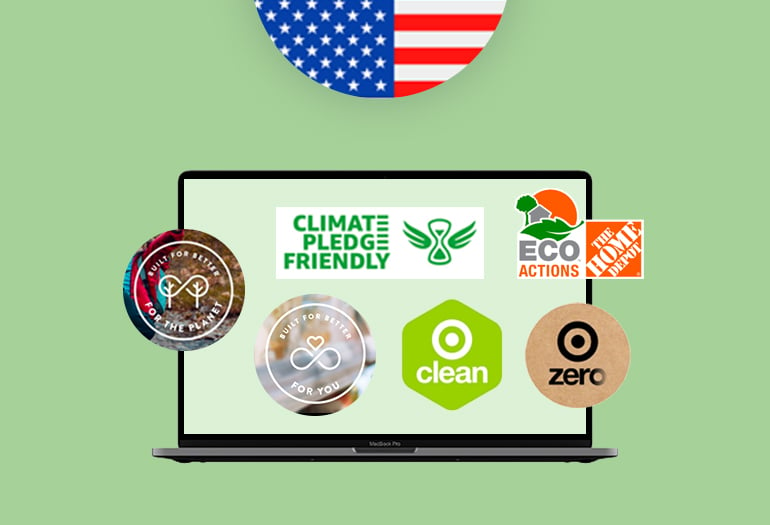

Environmental, social and corporate governance (ESG) factors — which measure the sustainability and societal impact of a company — are important. Six out of 10 shoppers are willing to change their shopping habits to reduce their environmental impact, according to IBM. Search data from Amazon shows consumers are searching for environmentally friendly products more than they were just a few years ago. Searches for key terms like "water bottle," "metal straw reusable," and "reusable grocery bags" have increased by more than 2,000% since April 2020. A November 2021 survey by Acosta found that 65% of shoppers want retailers to invest more in sustainability.
These kinds of consumer sentiments should give brands plenty of motivation to ensure their products are eco-friendly and their business practices are sustainable. But it’s also important that their ESG-friendly initiatives are recognized – and that brands are getting credit with consumers for their efforts (e.g., earning special badges, listings on sustainability pages, etc.) when selling on retailer websites.
But one size doesn’t fit all. The availability of eco-friendly badges or icons and other sustainability designations differs across retailer websites. In this blog, we compare and contrast ways brands can make their ESG-friendly products stand out on some of the most highly trafficked U.S. eCommerce sites.
A quick look at how eco-friendly products and brands can stand out on retailer websites
Source: Profitero
|
Amazon (1P) |
Best Buy |
Home Depot |
Instacart |
Kroger |
Target |
Walmart |
|
|
Eco-friendly badges are displayed on search result pages (SERPs) |
Y |
N |
Y |
N |
N |
N |
N |
|
“Eco-friendly/sustainability” certification earns special designation on site |
Y |
N |
Y |
N |
N |
Y |
Y |
Amazon: Eco-friendly icons and sustainability callouts
Amazon sustainability initiatives are ambitious. The retailer is driving toward net-zero carbon emissions across its operations by 2040. Initiatives include transitioning to an all-electric delivery vehicle fleet; launching sustainable Amazon devices; and encouraging its brand partners to make their products, packaging and processes more eco-friendly. Amazon first introduced the Climate Pledge Friendly badge (similar to the more familiar Amazon Choice and Best Seller badges brands earn on Amazon) on its site in 2020. More than 200,000 products on Amazon carry the Climate Pledge Friendly seal as of October 2021.
PRO TIP: Get a Climate Pledge Friendly badge on Amazon to highlight products that have earned sustainability certifications
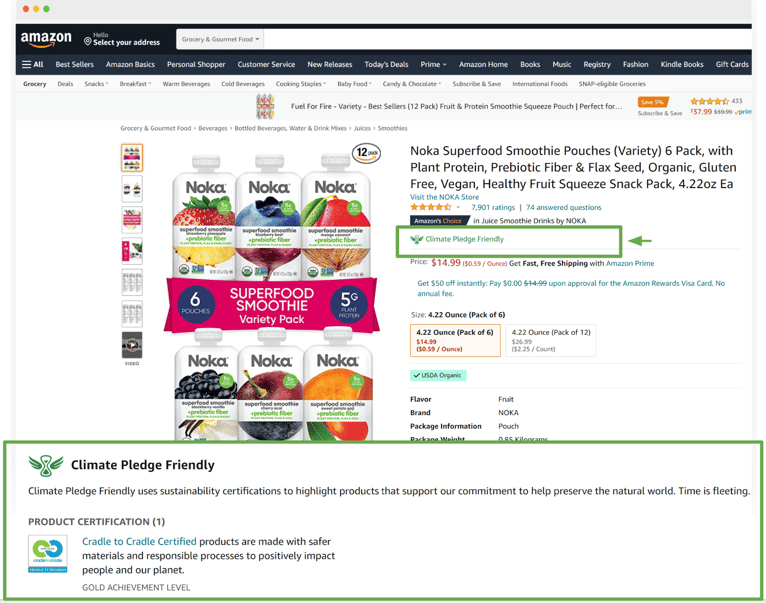
PRO TIP: Drive traffic to your Amazon PDPs with Climate Pledge Friendly icons, which are displayed in search results with pop-up windows showing your certifications
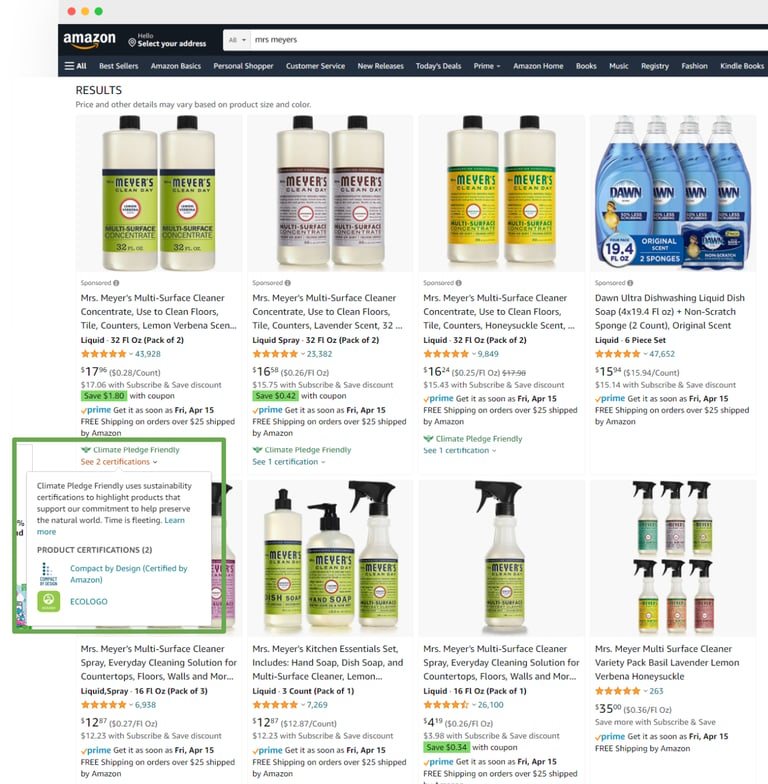
PRO TIP: Use the Climate Pledge Friendly section in search results to draw attention to additional eco-friendly products in your portfolio
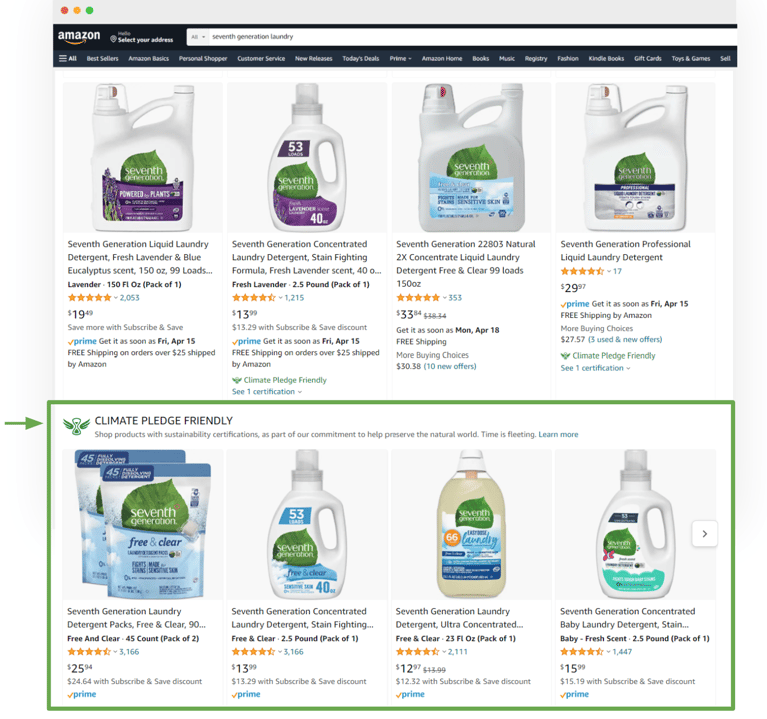
PRO TIP: Ensure your products are correctly tagged so they show up when consumers filter for Climate Pledge Friendly products on Amazon
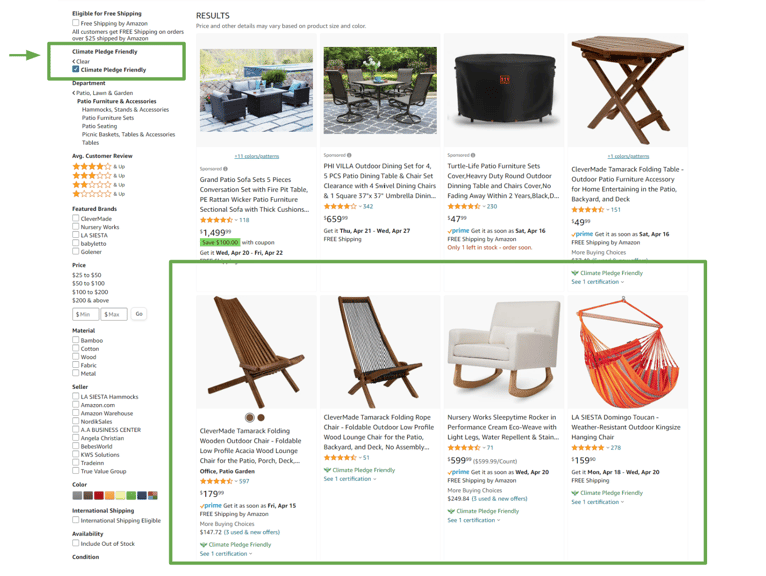
PRO TIP: Leverage opportunities to showcase your Climate Pledge Friendly products on Amazon Live

The Home Depot: Eco-friendly icons and sustainability callouts
Like other leading retailers, The Home Depot has goals to reduce its carbon footprint by making its operations more efficient and investing in alternative energy solutions. The retailer also publicly states that it “partners with suppliers focused on social and environmental responsibility, and we help our customers reduce their environmental impact by offering products and packaging created with sustainability in mind.”
To this end, The Home Depot launched its Eco Options program to help shoppers identify products that have a reduced impact on the environment. Brands can receive the Eco Options classification by The Home Depot by documenting attributes that prove its products have less of an impact on the environment than comparable products in its category. The retailer showcases these products in a unique way on its Eco Actions page, as illustrated in the examples below.
PRO TIP: Push to have your products added to The Home Depot’s “Eco Actions” page by submitting the required documentation and certifications
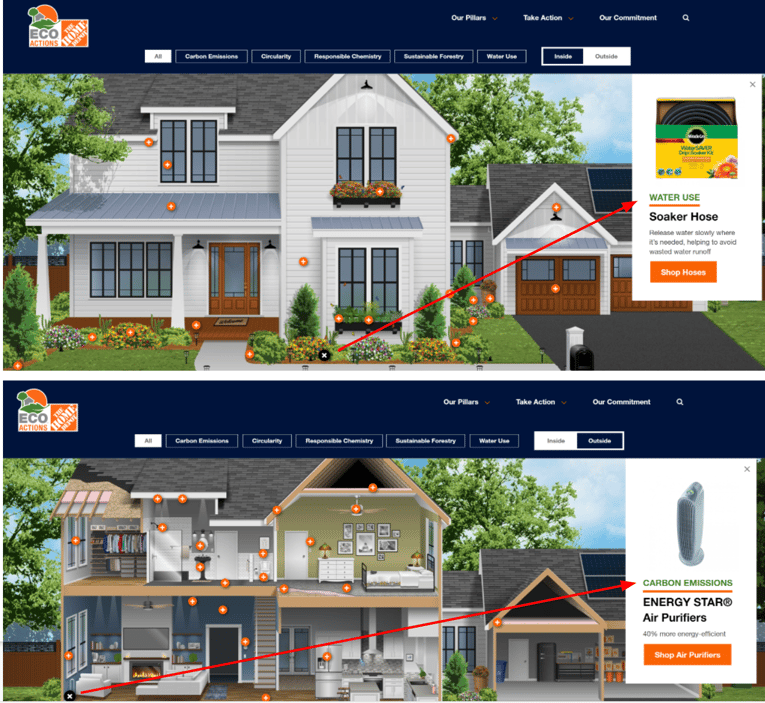
PRO TIP: Be sure any eco-friendly icons and sustainability certifications are visible in your product thumbnails on The Home Depot search results pages
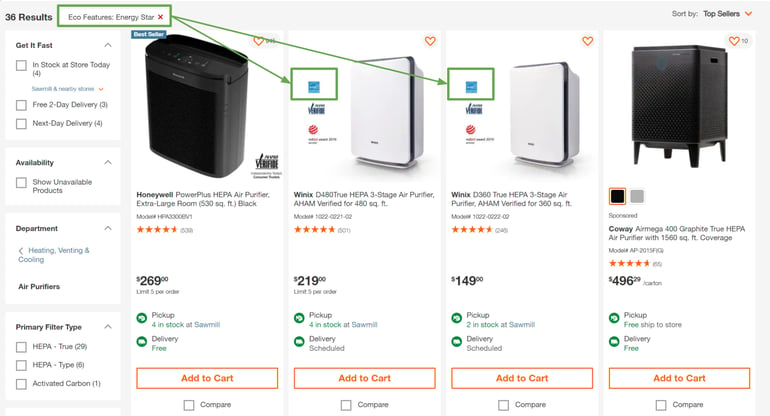
Target: Eco-friendly icons and sustainability callouts
Target launched its latest sustainability strategy dubbed Target Forward in 2021. Designing and elevating sustainable brands is a core pillar of this strategy. The company’s goals include: To become the market leader in creating and curating sustainable brands and experiences by 2030; and to have 100% of its own brands designed for a circular future – this means designed to eliminate waste, using regenerative materials, selling sustainably sourced products, and creating products that are more durable, easily repaired or recyclable – by 2040.
Driving toward these goals, Target launched its Target Clean icon in 2019, which is awarded to products formulated without some commonly unwanted chemicals (e.g., phthalates, sodium laureth sulfate, propyl-paraben and butyl-paraben). Just last month Target announced the creation of Target Zero, a curated collection of existing and new products from brands that are leading the way in reducing waste and making it easier for Target guests to shop sustainably. The new program was introduced both online and in-store.
PRO TIP: Work to get your products short-listed as part of the Target Zero program if you're a sustainable and eco-friendly brand
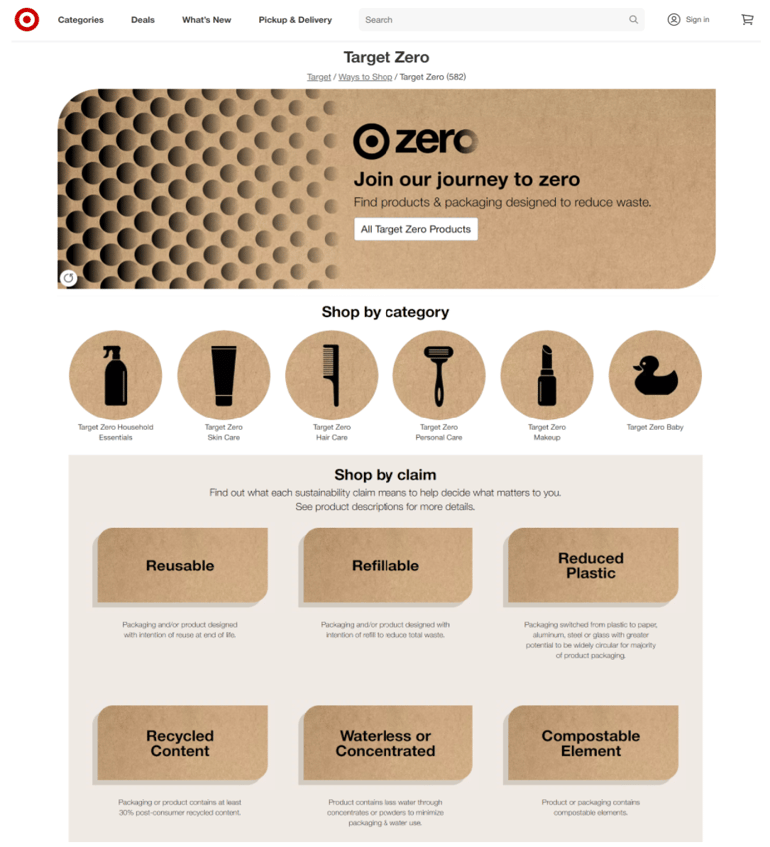
PRO TIP: Submit all your item attributes so Target can list them as “At a glance” icons on your PDPs, which are also used as filters in search queries
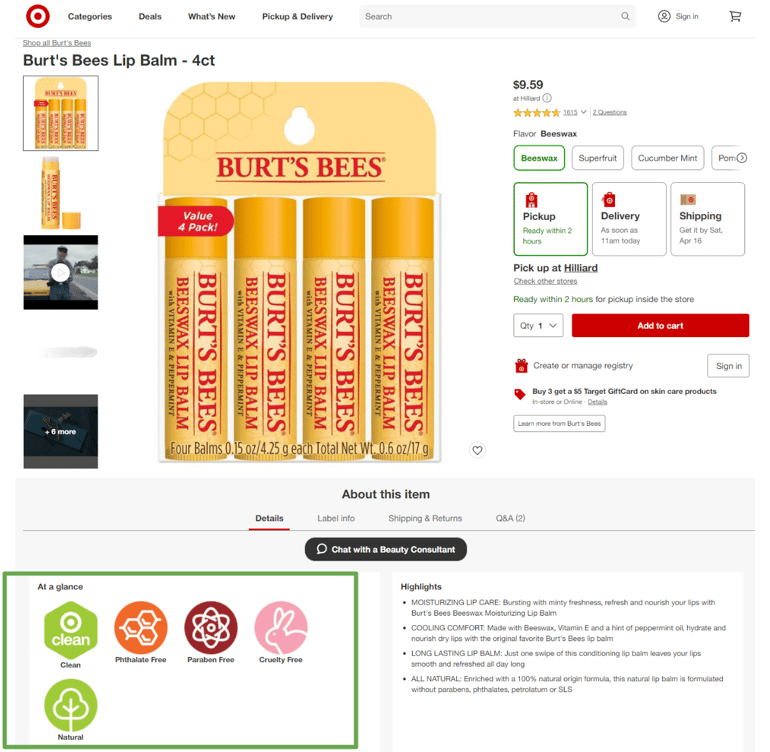
Walmart: Eco-friendly icons and sustainability callouts
Walmart prioritizes sustainability among its ESG efforts. The retailer is focused on: (1) zero waste in operation, products and packaging; (2) climate and renewable energy leadership; (3) regeneration of natural resources; and (4) sustainable product supply chains. Walmart has set some lofty goals for each of these. For example, the retailer wants to achieve 100% recyclable, reusable or industrially compostable packaging by 2025. Most recently, Walmart’s Circular Connector launched in early April as an online tool designed to “bridge the gap between companies searching for more sustainable packaging ideas and those that offer them.” Walmart also has introduced “Built for Better” icons to help differentiate good-for-you and good-for-the-planet” products.
PRO TIP: Ensure your products are tagged correctly to show up on Walmart’s “Built for Better” and “Earth Day” shops, as applicable
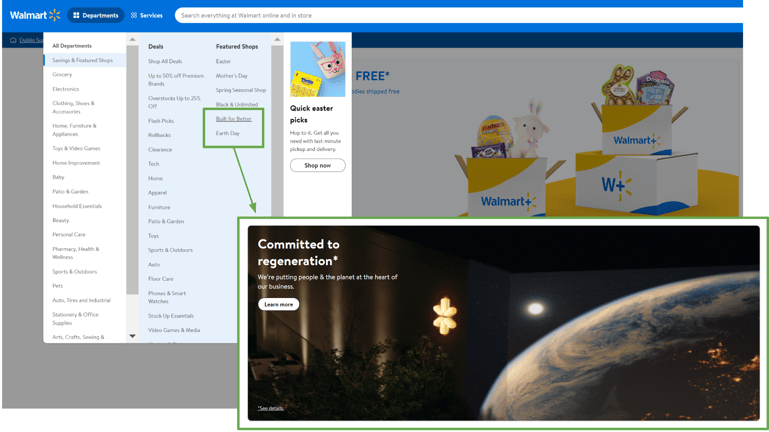
PRO TIP: Get your products certified to earn placement on Walmart’s sustainability pages: Built for Better—For the Planet and Built for Better—For You
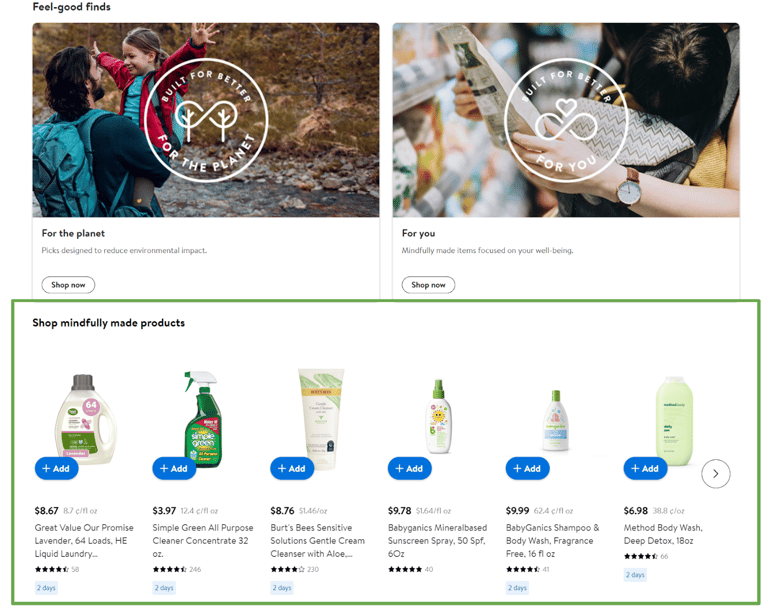
So what? Now what?
-
Identify and optimize for relevant “eco-friendly” keywords. Consumers are actually searching for environmentally conscious products more this year compared with a year ago, according to Profitero’s research. So make sure you regularly monitor search frequency and volumes to align your keywords – for both organic and paid sponsorship – with the most frequently searched terms. This is important because our research shows that optimizing for relevant, high-frequency keywords gets you 2X the sales lift as low-frequency keywords.
|
Increase in Amazon keyword search frequency rank since April 2020 |
|
|
“water bottle(s)” |
+7,617% |
|
“metal straws reusable” |
+3,826% |
|
“reusable grocery bags” |
+2,089% |
|
“sustainable products” |
+717% |
|
“LED light bulb” |
+563% |
Source: Amazon; Profitero; Time frame: week of Apr 16, 2022 vs. week of Apr 18, 2020
-
Making your products eco-friendly can improve your eComm unit economics. Less packaging, less water, etc., means fewer big, bulky or heavy items, which can actually help your eCommerce profitability. Improved margins can result from lower shipping costs (i.e., due to a much more favorable price:weight ratio) and minimizing breakage, which means fewer product returns and happier customers. So, socialize the benefits of making eco-friendly products throughout the organization, paying particular attention to educating Supply Chain, R&D and New Product Development / Innovation teams.
-
Make sure your digital shelf reflects any eco-friendly products in your portfolio by following the pro tips provided above. Some additional actions you should take:
- Incorporate product sustainability and environmentally friendly characteristics and benefits into your text (titles, descriptions, bullets and A+/enhanced content) on retailer PDPs
- Make sure your imagery — photos and videos — showcases your product’s eco-friendly elements
- Implement content tracking to make sure your PDPs are always showing your eco-friendly content accurately
- Optimize for relevant keywords like “eco-friendly,” “environmentally friendly,” “sustainable,” “recyclable,” “biodegradable,” etc.
- Measure the impact of your efforts – using metrics like search rank, market share and sales growth – to document how going green can lead to more green.


























